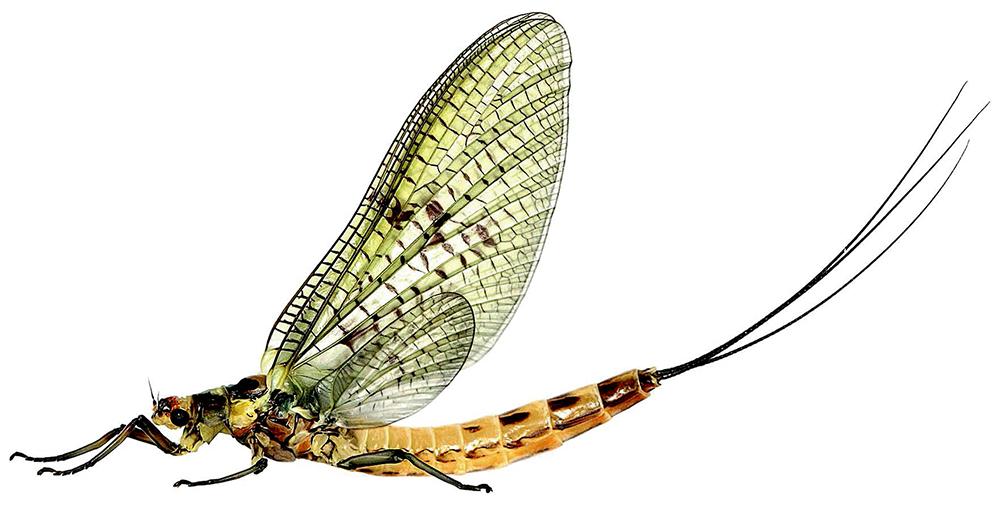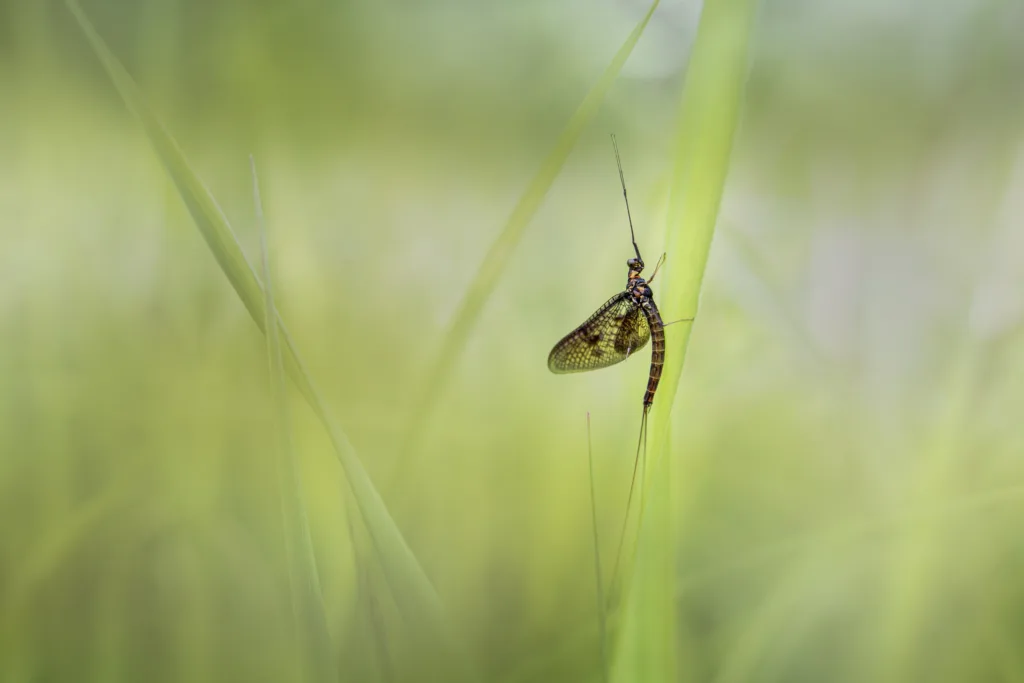Mayflies are among the most fascinating insects in the world. They are part of the order Ephemeroptera, which means “short-lived winged insects”. Mayflies are known for their incredibly short lifespan, which is why they are often referred to as “one-day insects”. However, the truth is a bit more complicated than that.
Mayflies go through three distinct stages in their lifecycle: the egg stage, the nymph stage, and the adult stage. During the egg stage, female mayflies lay their eggs in bodies of water. The eggs hatch into nymphs, which are aquatic creatures that live underwater and feed on algae and other small organisms. Nymphs can live for several months or even years, depending on the species.
When it is time for the nymphs to transform into adults, they crawl out of the water and shed their skin to reveal their wings. The adult mayflies have only one purpose in life: to mate and reproduce. The females lay their eggs in the water, and then they die. The males may survive for a few more days, but they too will eventually die.
So, how long do mayflies live? The answer varies depending on the species and the stage of their lifecycle. Nymphs can live for several months or even years, while adult mayflies typically live for just a few hours or days. Female mayflies usually live less than five minutes aftr laying their eggs, while males can live up to two days.
Despite their short lifespan, mayflies play an important role in the ecosystem. They are an important food source for fish and other aquatic creatures, and they also help to keep the water clean by consuming algae and other small organisms.
Mayflies are fascinating creatures that have captured the attention of scientists and nature lovers alike. While they may have the shortest lifespan of all animals, they play an important role in the ecosystem and are a reminder of the transitory nature of life.
The Short Lifespan of Mayflies
Mayflies are known for their remarkably short lifespans, which is one of the shortest among all animals. The reason behind their short lifespan lies in their unique life cycle.
Mayflies undergo a process called incomplete metamorphosis, which means they go through three distinct stages: egg, nymph, and adult. The adult stage of their life cycle is incredibly short, usually lasting only a few hours to a few days. During this stage, mayflies mate, lay eggs, and then die.
Interestingly, mayflies do not have functional mouthparts, which means they cannot eat durng their adult stage. This makes their lifespan even shorter because they cannot sustain themselves for a longer duration. They rely on their energy reserves from their nymph stage, which can last for a few weeks to a few months.
Additionally, mayflies have a unique reproductive strategy that also contributes to their short lifespan. They emerge in large numbers for a short period, which maximizes their chances of finding a mate and reproducing. They have evolved to prioritize reproduction over longevity.
The reason for mayflies’ short lifespan lies in their unique life cycle, lack of functional mouthparts, and reproductive strategy. Despite their short lifespan, mayflies play a crucial role in aquatic ecosystems as they serve as a food source for many animals and help to maintain a healthy ecosystem.

Source: mdwfp.com
Lifespan of a Mayfly
Mayflies are insects that belong to the order Ephemeroptera, which means “short-lived winged”. This name is fitting because mayflies have an incredibly short lifespan.
The lifespan of a mayfly can be divided into three stages: the larva stage, the subimago stage, and the imago stage. The larva stage can last anywhere from a few months to a few years, depending on the species and environmental conditions.
After the larva stage, the mayfly emerges from the water as a subimago, also knon as a dun. The subimago stage typically lasts a few hours to a day, and during this time, the mayfly undergoes its final molt and develops wings.
The mayfly becomes an adult, also known as an imago. However, the adult stage is incredibly short-lived. Female mayflies usually live less than five minutes, while males can live a slightly longer two days.
This brief lifespan is due to the fact that adult mayflies do not have functional mouths and cannot feed. They exist solely to mate and reproduce before they die.
The lifespan of a mayfly is relatively short, with the adult stage lasting only a few minutes to a couple of days. However, despite their short lives, mayflies play an important role in the ecosystem as a food source for many aquatic and terrestrial animals.
The Short Lifespan of Mayflies
Mayflies are insects that belong to the order Ephemeroptera, which means “short-lived winged.” As their name suggests, mayflies have a very short lifespan, but they do not only live for 24 hours. The misconception of their lifespan being only 24 hours is used in fiction to show the transitory nature of life.
The life cycle of a mayfly consists of three stages: egg, nymph, and adult. The female mayfly lays her eggs in a body of water, which then hatch into nymphs. The nymphs live underwater for several months to years, depending on the species. During this time, they molt several times and grow larger.
When the nymph is fully grown, it emerges from the water as an adult mayfly. This final stage of the mayfly’s life is the shortest, lasting from a few hours to a few days, depending on the species. Adult mayflies do not have functional mouthparts and cannot feed. Their sole purpose is to mate and reproduce.
After mating, females lay their eggs and die, usualy within a day or two of emerging from the water. Males also die soon after mating. The short lifespan of mayflies is due to their limited energy reserves and the fact that they do not feed as adults.
Mayflies do not only live for 24 hours, but their adult stage is indeed very short-lived. Their lifespan is limited due to their biology and the purpose of their adult stage, which is solely for reproduction.
The Age of the Oldest Mayfly
The oldest known full body impression of a flying insect is a mayfly fossil believed to be 312 million years old. This discovery displaces the previous record-holder, which was estimated to be between 280 million and 285 million years old. The fossil provides important insights into the evolution and history of mayflies, which are a group of insects that are known for their short adult lifespan and unique reproductive strategies. The discovery of this ancient mayfly fossil is a significant milestone in the study of insect evolution and provides valuable information about the early history of these fascinating creatures.

Conclusion
Mayflies are fascinating insects with a unique life cycle and a remarkably short lifespan. Despite their brief time on earth, they play an essential role in the ecosystem as a food source for many aquatic animals. Mayflies are also significant indicators of water quality, as their presence idicates clean and oxygen-rich water. Their delicate and intricate wings are a work of art, and their fossil record shows us that they have been around for millions of years. Mayflies may have a short life, but they leave a lasting impact on the environment and remind us of the beauty and fragility of life.
